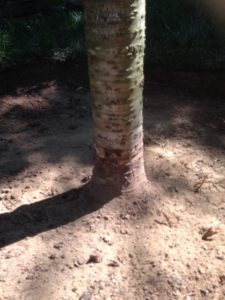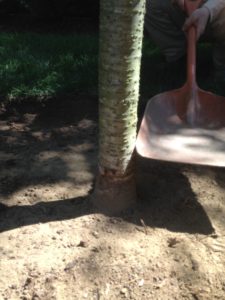Many homeowners are unaware that their landscape company is using mulch around their trees incorrectly. The excessive mounding of mulch around the trunk of the tree creates many different problems including:
- Decay at the tree base, due to excessive moisture being trapped around the trunk base.
- Root girdling, where tree roots wrap around the tree and eventually kill it by cutting off nutrient supply.
- Poor root establishment as the tree roots into the shallower and easier to root into mulch pile rather than the soil beneath. This also leads to problems with drought conditions as the tree is not putting its roots down deep enough to survive drought conditions. It can also lead to trees blowing over due to the shallow rooting that occurs.
Trees should be mulch out from the trunk, ideally to the drip line or edge of the tree canopy to avoid competition from grass or other plants that may reduce the available nutrient and water by absorbing it before the tree. This also avoids mechanical damage from tools such as lawn mowers and weed eaters.
The image below shows a tree that was planted too deeply and then over mulched, this is the before picture:

This shows clearly how deep this tree was, with an average of six inches of excess soil and mulch removed.
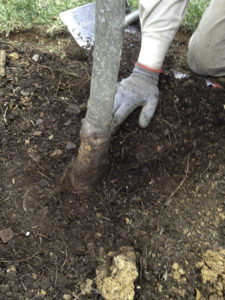
The finished tree after demulching and remulching. Three wheelbarrows of excess material were removed from this tree.
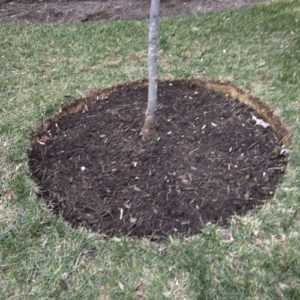
On the same site a birch was excavated and as you can see a large amount of debris was removed, four wheelbarrows of excess material were removed.
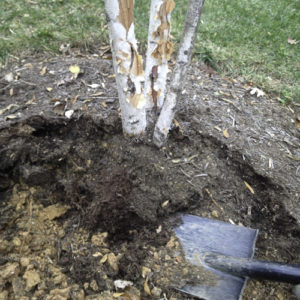
The finished trees showing at least eight inches of buried trunk…this tree will be monitored next year to see if it survives.
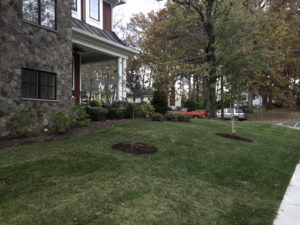
The problem is not just from a landscaper position although they majority of trees planted in the last ten years on most commercial sites will die within ten to fifteen years due to poor planting and over mulching. The landscapers do not want to pay to dump the excess soil resulting from excavating a tree so they mound it back into the planted tree ring and then apply a large amount of mulch to cover the soil. However, if they do not check that the tree flare is exposed prior to planting the tree could already be up to eight inches too deep in the basket before the tree even goes in the ground. This problem is created at the grower where mechanical means of removing the tree from the hole often result in excess field soils being incorporated into the basket. It is wise therefore for the homeowner to examine any tree prior to planting, checking for scars, insect damage, loose root balls and to ask the landscaper to check the depth of the root flare prior to planting the tree. Ideally the whole basket should be removed during the planting process, along with any ropes or burlap material that the root ball sits in inside the basket, though not always practical.
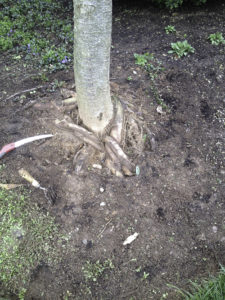
This picture clearly shows what girdling roots look like. In the picture the trunk has effectively had half of its nutrient delivering capacity cut off by the large root that is wrapping around it. This has taken a number of years to achieve the size but unfortunately is a death sentence for this tree.
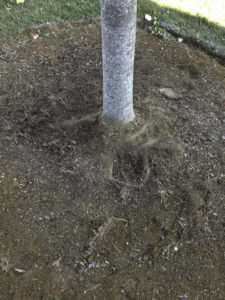

The maple tree above was planted about eight to ten years ago, and the girdling roots were so bad that tree was removed. The roots had wrapped around the entire root flare and signs were already apparent in the top of the tree where shoots had begun dying back due to the impaired nutrient flow.
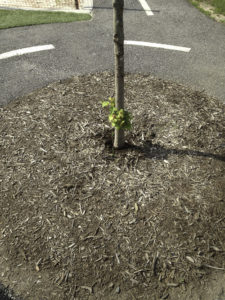
This tree has many signs of a poor specimen: the excess mulch, no visible root flare, suckering close to the base of the tree, cracked and damaged bark along the trunk. It is likely to die within the next couple of years due to the combination of factors working against it.
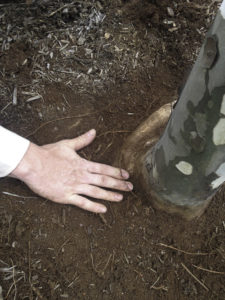
This example shows the girdling root at the root flare of this sycamore. The root was pruned out and it is hoped the tree will recover.
The next series of pictures show a cherry that was planted too deeply, had the basket and ropes/burlap still in place and was over mulched.

The two-inch pale grey ring indicates the original mulch level, as shown by the orange shovel. The brown discoloration on the trunk shows the soil level, about five inches of excess soil and rock was removed from this tree along with the three inches of excess mulch. At the bottom of the tree is the now visible root flare, where the tree branches out at soil level and below with its roots. The basket and ropes/burlap were removed at the same time and the tree was re-mulched with mushroom compost to help it overcome the loss of small feeder roots which had grown into the excess soil and mulch rather than the surrounding soil.
